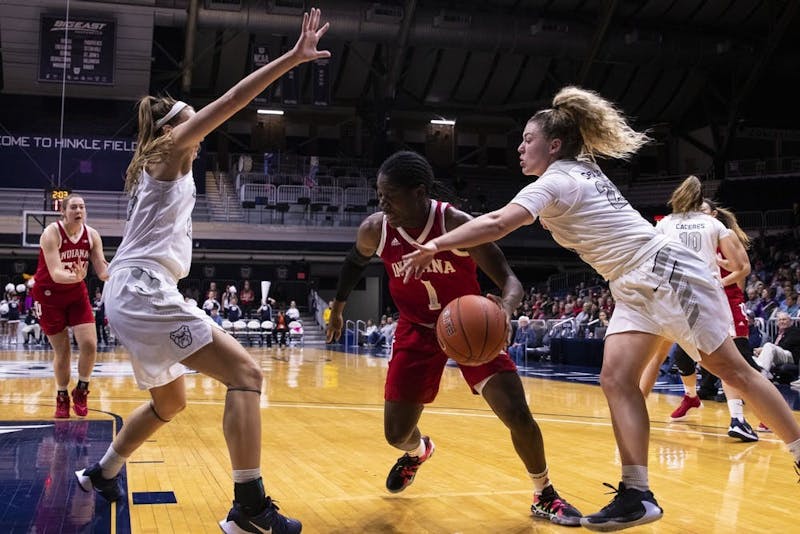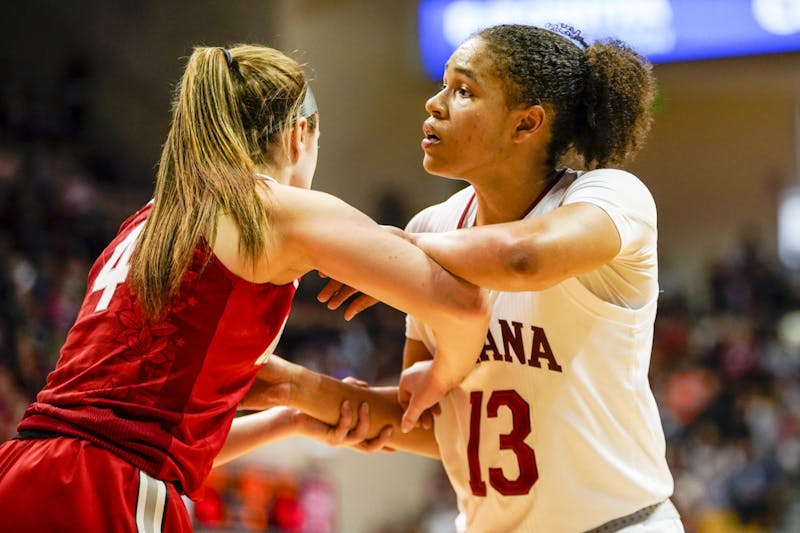2nd game I was able to see in person. The Gophs did some good things out there but I think the score pretty accurately reflected the difference between the teams. IU is a team that knows what it does well and doesn't deviate from it's plan. In the first half IU got almost every shot they wanted. Even when MN did contest it didn't matter. I though Patberg was really tired in the last 8 minutes or so.
In particular, the Hoosiers took a TON of mid range shots. It's really remarkable to see a team take so many pull up jumpers on the drive and other 10 to 15 foot shots. I was thinking it's a remarkably old fashioned way to play the game. Then I remembered their Coach is Dick Bennet's daughter. Of course they play a controlled, old school game.
Really tough to see the Gophers force one of IU's non scoring bigs into a last second three and watch it go in. Put them up by 5 and essentially put the game out of reach.
Best three-sentence summary of the Indiana game, especially Patberg and Berger:
>
@Frink: In the first half IU got almost every shot they wanted. Even when MN did contest it didn’t matter. ... In particular, the Hoosiers took a TON of mid range shots.
It’s interesting to look at the shot charts - in particular the PDF stats have a blow-up chart that shows just the rectangular paint area plus about a foot either side of the paint. For this area ...
The Hoosiers shot 21-39 (.538) for 42 points, and the Gophers shot 11-32 (.344) for 22 points. In the first half the Gophers shot 6-12 from deep, but only 2-5 from deep in the second half (for a total of 8-17 or .471). Our long-range shooting was good both halves - it’s just that Indiana’s defense prevented us from shooting enough triples in the second half. Indiana was 2-4 in the first half on triples, plus the 1-1 dagger in the 4th quarter (for a total of 3-5 or .600). So the margin was +5 triples or +15 points-off-triples margin for Minnesota. That comes up short relative to the +20 points in the paint for Indiana. And wouldn’t ya know it, that dagger three made all the difference. In fact, the delta between Indiana's in-the-paint margin and Minnesota’s three-point margin, pretty much explains the Indiana victory margin.
Minnesota, who lives and dies by its triples, died this time because even though they shot em well, we just couldn’t launch enough of them in the second half. All our three-point shooters are set-shot shooters (not true jump-shot shooters like Patberg shoots twos). Thus we need enough space to get our shot off. Indiana didn’t give us that space in the second half. We were doing somewhat good at penetrating then kicking it out, but not enough of that in the second half.
Plus our in-the-paint shooting was crappy.
Along with Iggy’s description of our 4Q field-goal dry spell from 7:27 to 1:24, here’s the best two-sentence description of what went wrong in the 4th quarter:
>
@Frink: Really tough to see the Gophers force one of IU’s non scoring bigs into a last second three and watch it go in. Put them up by 5 and essentially put the game out of reach.
That dagger 3 by a non-three-point shooter seemed especially ironic since we had a ton of highly makable shots roll around the rim and out.
In our 4Q field-goal drought from 7:27 through 1:24 we made 3 free shots ithrows but missed three 3-pointer attempts and four 2-pointer attempts (two of which were layup attempts). During the same period of time, Indiana made four 2-pointers plus the one dagger triple (for 11 points), but also had time to miss eight 2-pointer attempts. In other words, they had 13 field-goal attempts to our 7 field-goal attempts. The difference in attempts was one turnover by us, and better rebounding by them. During this time, Indiana wasn’t shooting terrific (except for the dagger three) but just shooting their 2-pointers in workman-like fashion. It’s their modus operandi.
But we scored zilch in that six minutes. Fourth quarter droughts have been an ongoing problem for us, this year and last year. Apparently that’s our modus operandi.
One 20/20 hindsight observation from the Indiana game might lead to a strategy that could be used to win the B1G Tournament.
We only shot .344 from the paint for an expected point production of E(Paint_shot) = 2 * .344 = 0.688 points. On the other hand, we shot .471 from three-point range for an expected point production of E(Triple_shot) = 3 * .471 = 1.413 points. Note that the ratio E(Triple_shot) / E(Paint_shot) = 2.05. That is, in the Indiana game, a trey attempt generated twice as many points, on average, than a shot from the paint. Conclusion: We shot too many shots from the paint, and too few shots from beyond the arc.
This suggests that we’ve been doing this all wrong, and have probably been doing things all wrong since the start of the Big-Ten season. At the Indiana game we shot a mixture of 77.6% two-point shots and 22.4% three-point shots. Aside from Brunson shots from the top of the key (which she hits at a high rate, so we need to keep on doing that) plus a few open-look just-sub-three-point shots (which are quality if open), the bulk of our two-pointer attempts were from the paint.
Why would you want to take such a large portion of your 77.6% of two-pointers in the paint when E(Paint_shot) = only 0.688 points, when you could have shot a three-pointer whose expected value is over twice as large at E(Triple_shot) = 1.413 points? Under such a scenario, one should ideally refrain from shooting in the paint, unless the probability of making the shot is 77% or better (or perhaps a slightly lower threshold if you were certain you’d be fouled).
You wouldn’t and we shouldn’t. Instead of a 22.4%/77.6% mix of three-point/two-point shots, we should have taken (say - just a ballpark guess) a 60%/40% mix of three-point/two-point shots!
If we had done the latter mix with our 76 shots, we would have had about (rounding down) 45 triple attempts and 31 two-point attempts. Our trey attempts alone should net us over 63 points. Add in our (assumed half as many for simplicity) 8 made free throws, gives 71 points so far. Now recall that we actually scored 69 points and Indiana scored 75. So our revised strategy outscored our actual score by two points already without counting two-pointers. Our target is 76 points for the win, which needs 5 points out of our 31 two-point attempts. We thus need to shoot .161 or more on two-pointers. That’s easy to do. Even at our bad in-the-paint shooting (in)efficiency of 0.688 per paint shot, we could expect 31 * 0.688 = over 21 points off those 31 two-pointer attempts. Add in the 71 off treys and free throws, and we conclude that we could have scored over 102 points against Indiana. And that’s even including our misfortunes, such as that former dagger three that now just reduces our victory margin a bit (we win 102-75 under the revised game plan).
In other words, as long as we are shooting well from deep, this team should be shooting “almost all threes almost all of the time.” The way to achieve launching those extra triples that we needed to do in this game, would be to (a) almost always kick it back out when you penetrate into the paint, and (b) almost always kick out an offensive rebound.
That being said, if Taiye is not being double teamed, it still makes sense for her to make a post move, or shoot a putback if virtually uncontested; and if Powell penetrates and has a clean shot or a clean dish, she should take it.
But what the situation calls for (for the rest of the season) is a radical change in shot mixture that doubles (or maybe even triples) the number of three-pointer shots attempted per game.
If we’re a little cold on threes for awhile, we shift back more toward a normal mix and/or put in another post to get more rebounds. (Offensive rebounds would mostly get us a second chance to shoot a triple in the new scheme of things.)
Our team lives and dies by the triple in any event, so might as well go all-in on shooting threes, by intentionally shooting a radically large percentage of threes, to be adjusted dynamically during the game as needed.
There’s a trend toward shooting more threes anyway. What I’m saying is that the Gophers need to make a really radical quantum leap in that trending direction, to the point of matching or exceeding the percentage of triples shot by the Golden State Warriors.
With this change, and assuming that the guards are shooting “normally” from deep, the Gophers could score 100+ points on any team in the Big Ten - including Indiana, Iowa, Maryland and Northwestern.
One proviso if we should try this, though. The coaches need to be merciless in benching a guard who is shooting bricks from deep. Let em rest, they’ll shoot better when they come back in. We can’t have any of this 1-8 individual stat on threes. If not enough shooters are hitting threes well, then you put in a second post and focus on rebounding and scoring in the paint for a while.


